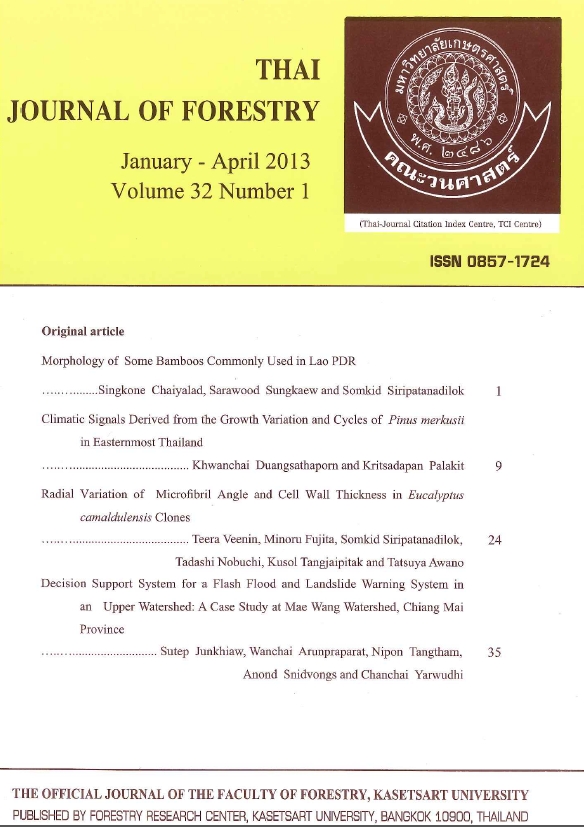Decision Support System for a Flash Flood and Landslide Warning System in an Upper Watershed: A Case Study at Mae Wang Watershed, Chiang Mai Province
Main Article Content
บทคัดย่อ
To save people’s lives, the Decision Support System (DSS) for a flash flood and landslide warning system in an upper catchment of the Mae Wang watershed was developed involving the development of the methodology, models, and locations of the warning system. A general package radio service (GPRS) system was determined to be the most suitable and was selected. It used GPRS technology for data transmission and remote control. After evaluating GPRS technology against a very high frequency-based system, a synchronized communication system, and a satellite system. The system prototype included four automatic rain gauges, two water level sensors and three soil moisture sensors that were installed at the four stations-namely, Khun Wang (STA01), Tung Khlung (STA02), Sop Win (STA03), and Pun Ton(STA04).
The antecedent precipitation Index (API) that was used to predict landslide warnings was determined from rainfall simulation in four land use types: dry dipterocarp forest, hill evergreen forest, degraded forest, and agricultural land, with API crisis values of 221.50, 400.00, 325.59, and 248.86 mm, respectively. The flash flood warning system used the correlation of rainfall at three stations to predict the water level at STA03and the relationship between the water level at STA03 and STA04 to define the warning area. Accumulated 24 hr rainfall critical values of STA01, STA02, and STA03 were 100.00, 145.00, and 221.50 mm, respectively. The relationship between the two water levels could be estimated by the equation: y = 2.382ln(x) + 1.0032 (r² = 0.763) where y is the water level (m) at STA04 and x is the water level (m) at STA03 and the flow timing of water movement was forecast by the equation T = 25.576e-0.465x (r² = 0.69) where T is the travel time(hr) from the STA03 to STA04 and x is the water level(m) at STA03. The critical water level at STA03 was 3.58 m for warning villages located below STA04 and 3.10 m for villages located above STA04.
Keywords: Decision support system (DSS), Flash flood and landslide, Early warning system (EWS), Upper watershed, Mae Wang watershed
Downloads
Article Details

อนุญาตภายใต้เงื่อนไข Creative Commons Attribution-NonCommercial-NoDerivatives 4.0 International License.
ข้าพเจ้าและผู้เขียนร่วม (ถ้ามี) ขอรับรองว่า ต้นฉบับที่เสนอมานี้ยังไม่เคยได้รับการตีพิมพ์และไม่ได้อยู่ในระหว่างกระบวนการพิจารณาตีพิมพ์ลงในวารสารหรือสิ่งตีพิมพ์อื่นใด ข้าพเจ้าและผู้เขียนร่วม (ถ้ามี) ยอมรับหลักเกณฑ์และเงื่อนไขการพิจารณาต้นฉบับ ทั้งยินยอมให้กองบรรณาธิการมีสิทธิ์พิจารณาและตรวจแก้ต้นฉบับได้ตามที่เห็นสมควร พร้อมนี้ขอมอบลิขสิทธิ์ผลงานที่ได้รับการตีพิมพ์ให้แก่วารสารวนศาสตร์ คณะวนศาสตร์ มหาวิทยาลัยเกษตรศาสตร์ กรณีมีการฟ้องร้องเรื่องการละเมิดลิขสิทธิ์เกี่ยวกับภาพ กราฟ ข้อความส่วนใดส่วนหนึ่ง หรือ ข้อคิดเห็นที่ปรากฏในผลงาน ให้เป็นความรับผิดชอบของข้าพเจ้าและผู้เขียนร่วม (ถ้ามี) แต่เพียงฝ่ายเดียว และหากข้าพเจ้าและผู้เขียนร่วม (ถ้ามี) ประสงค์ถอนบทความในระหว่างกระบวนการพิจารณาของทางวารสาร ข้าพเจ้าและผู้เขียนร่วม (ถ้ามี) ยินดีรับผิดชอบค่าใช้จ่ายทั้งหมดที่เกิดขึ้นในกระบวนการพิจารณาบทความนั้น”


